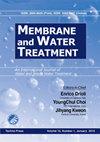Optimization of chemical cleaning of discarded reverse osmosis membranes for reuse
IF 1.1
4区 工程技术
Q4 ENGINEERING, CHEMICAL
引用次数: 0
Abstract
This study optimized the chemical cleaning process of discarded RO membranes for reuse in less demanding separation processes. The effect of physicochemical parameters, including the temperature, cleaning time, pH of the cleaning solution, and addition of additives, on the cleaning process was investigated. The membrane performance was evaluated by testing the flux recovery rate and salt rejection before and after the cleaning process. High temperatures (45-50oC) resulted in a better flux recovery rate of 71% with more than 80% salt rejection. Equal time for acid and base cleaning 3-3 h presented a 72.43% flux recovery rate with salt rejection above 85%. During acid and base cleaning, the best results were achieved at pH values of 3.0 and 12.0, respectively. Moreover, 0.05% concentration of ethylenediaminetetraacetic acid presented 72.3% flux recovery, while 69.2% flux was achieved using sodium dodecyl sulfate with a concentration of 0.5%; both showed >80% salt rejection, indicating no damage to the active layer of the membrane. Conversely, 0.5% concentration of sodium percarbonate showed 83.1% flux recovery and 0.005% concentration of sodium hypochlorite presented 85.2% flux recovery, while a high concentration of these chemicals resulted in oxidation of the membrane that caused a reduction in salt rejection.废弃反渗透膜再利用的化学清洗优化
本研究优化了废弃反渗透膜的化学清洗工艺,以便在要求较低的分离过程中重复使用。考察了清洗温度、清洗时间、清洗液pH、助剂添加量等理化参数对清洗过程的影响。通过测试清洗前后的通量回收率和除盐率来评价膜的性能。高温(45 ~ 50℃)可使熔剂回收率达到71%,脱盐率达到80%以上。等时间酸碱清洗3-3 h,通量回收率为72.43%,除盐率在85%以上。酸碱清洗时,pH值分别为3.0和12.0时效果最佳。0.05%浓度的乙二胺四乙酸的通量回收率为72.3%,0.5%浓度的十二烷基硫酸钠的通量回收率为69.2%;两者均显示出>80%的盐排斥,表明膜活性层未受到损伤。相反,0.5%浓度的过碳酸钠通量回收率为83.1%,0.005%浓度的次氯酸钠通量回收率为85.2%,而高浓度的这两种化学物质会导致膜氧化,从而降低盐的截留率。
本文章由计算机程序翻译,如有差异,请以英文原文为准。
求助全文
约1分钟内获得全文
求助全文
来源期刊

Membrane Water Treatment
ENGINEERING, CHEMICAL-WATER RESOURCES
CiteScore
1.90
自引率
30.00%
发文量
0
审稿时长
>12 weeks
期刊介绍:
The Membrane and Water Treatment(MWT), An International Journal, aims at opening an access to the valuable source of technical information and providing an excellent publication channel for the global community of researchers in Membrane and Water Treatment related area. Specific emphasis of the journal may include but not limited to; the engineering and scientific aspects of understanding the basic mechanisms and applying membranes for water and waste water treatment, such as transport phenomena, surface characteristics, fouling, scaling, desalination, membrane bioreactors, water reuse, and system optimization.
 求助内容:
求助内容: 应助结果提醒方式:
应助结果提醒方式:


